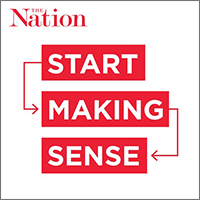 John Nichols says Trump sent Jeff Sessions out to announce that the administration was targeting the Dreamers for deportation because Sessions has always been bitterly anti-immigrant, and helped bring that constituency into Trump’s base.
John Nichols says Trump sent Jeff Sessions out to announce that the administration was targeting the Dreamers for deportation because Sessions has always been bitterly anti-immigrant, and helped bring that constituency into Trump’s base.
Also: Trump could fire Mueller or pardon all of his targets—but that won’t protect him from investigation by the state of New York, and Mueller has formed a partnership with New York’s state Attorney General Eric Schneiderman. Elizabeth Holtzman explains—she’s a former member of Congress from New York who won national attention for her work on the House Judiciary Committee during Watergate.
Plus: You’ve probably had this debate with your friends: Do we want Donald Trump to resign or be impeached, which would leave us with Mike Pence in charge? Would Pence would be better, or worse, than Trump? Joan Walsh has been thinking about this too—and she’s got some hard evidence and an original analysis.
Listen HERE
The Political Roots of Houston’s Flooding
 A Q&A with The Nation’s Managing Editor, Roane Carey, who spent the week trapped in Houston — studying the history of 100-year floods, and developers’ fight against local groups seeking limits of development of prairie flood plains.
A Q&A with The Nation’s Managing Editor, Roane Carey, who spent the week trapped in Houston — studying the history of 100-year floods, and developers’ fight against local groups seeking limits of development of prairie flood plains.
At TheNation.com, HERE
Erwin Chemerinsky: Trump’s Terrible Pardon of Sherriff Joe Arpaio
 Q&A with the dean of the law school at Berkeley, who explains why Trump’s move violates basic tenets of the separation of powers–and how the Supreme Court might review the pardon.
Q&A with the dean of the law school at Berkeley, who explains why Trump’s move violates basic tenets of the separation of powers–and how the Supreme Court might review the pardon.
at TheNation.com: READ HERE
Robert Mueller’s Brilliant Tactics Against Trump: Watergate Veteran Elizabeth Holtzman Explains
 Elizabeth Holtzman, who served on the House Judiciary Committee that brought articles of impeachment against Nixon, reviews the case against Trump at this point — and what special counsel Robert Mueller is doing to protect his investigation.
Elizabeth Holtzman, who served on the House Judiciary Committee that brought articles of impeachment against Nixon, reviews the case against Trump at this point — and what special counsel Robert Mueller is doing to protect his investigation.
Also: Trump vs. Trans soldiers and sailors: the ACLU is taking him to court for violating the equal protection clause of the bill of rights. Chase Strangio explains.
And John Nichols of The Nation talks about his new book Horsemen of the Trumpocalypse, and what Trump’s people been doing about the floods in Texas–especially Steven Mnuchin, Mike Pence, and Elaine Chao.
Listen HERE
Houston Developers’ Losing Battle With Climate Change: Roane Carey, plus Erwin Chemerinsky on Trump’s pardon of Joe Arpaio and Bob Dreyfuss on Seth Rich.
 Roane Carey, The Nation’s managing editor, reports from Houston on the political battles there: Developers have defeated local anti-growth groups, but they can’t stop the climate changes that have brought unprecedented rainfall and flooding.
Roane Carey, The Nation’s managing editor, reports from Houston on the political battles there: Developers have defeated local anti-growth groups, but they can’t stop the climate changes that have brought unprecedented rainfall and flooding.
Plus: Erwin Chemerinsky, the new dean of the law school at UC Berkeley, says Trump’s Pardon of Sheriff Joe Arpaio is “outrageous”—because it violates the separation of powers, and encourages the police to ignore Latinos’ constitutional right to liberty.
And if you wanted to discredit the idea that Russians hacked the DNC and sent what they found there to Wikileaks to help Donald Trump, you’d need a counter-theory—right? Bob Dreyfuss looks at the leading Republican counter-theory, and how it crashed and burned.
Trump Without Bannon: The Emptiness at the Center–Amy Wilentz on What Jared Wants
 Jon Wiener: We heard for months about the hostility between Steve Bannon and Jared Kushner. Now Jared has won the battle. But why was this battle being fought, in the first place?
Jon Wiener: We heard for months about the hostility between Steve Bannon and Jared Kushner. Now Jared has won the battle. But why was this battle being fought, in the first place?
Amy Wilentz: There’s an emptiness at the center of Donald Trump. He doesn’t like policy, doesn’t want to read about policy, doesn’t want to think about policy. What he does is take advice. If you have then two warring factions who disagree on policy and also disagree on final goals, you’re going to have huge problems.
. . . continued at TheNation.com, HERE
It Was 50 Years Ago Today: Abbie Hoffman Threw Money at the New York Stock Exchange
 On August 24, 1967, fifty years ago today, Abbie Hoffman and a group of friends invaded the heart of American capitalism, the New York Stock Exchange on Wall Street. They threw money from the visitors’ gallery onto the floor, and the brokers and traders there leapt into the air to grab the dollar bills floating down. Trading was interrupted, briefly. News coverage was massive. . . .
On August 24, 1967, fifty years ago today, Abbie Hoffman and a group of friends invaded the heart of American capitalism, the New York Stock Exchange on Wall Street. They threw money from the visitors’ gallery onto the floor, and the brokers and traders there leapt into the air to grab the dollar bills floating down. Trading was interrupted, briefly. News coverage was massive. . . .
. . . continued at TheNation.com, HERE
Trump/Nixon: Frank Rich ‘Wallowing in Watergate’; plus Robert Lipsyte on Trump & Golf, and Bruce Dancis on Abbie Hoffman
 Frank Rich has been “wallowing in Watergate,” as he put it, and found some fascinating stuff about Trump’s situation today and Nixon’s a year before his fall. Also: the ways Nixon was significantly stronger than Trump in resisting impeachment and resignation.
Frank Rich has been “wallowing in Watergate,” as he put it, and found some fascinating stuff about Trump’s situation today and Nixon’s a year before his fall. Also: the ways Nixon was significantly stronger than Trump in resisting impeachment and resignation.
Also: if you understand golf, you understand Trump. Golf is a game for “successful greedheads and their wannabes,” says legendary sportswriter Robert Lipsyte. It’s a waste of space and water, and it poisons local aquifers with chemicals. And it represents all that is retrograde and exclusionary in American life. Lipsyte asks, Doesn’t that remind you of our president?
Plus: It was 50 years ago today: Abbie Hoffman and friends invaded the heart of capitalism, the New York Stock Exchange on Wall Street, and threw money from the gallery onto the trading floor. Bruce Dancis explains what happened on Aug. 24, 1967–he was there.
Listen HERE
Steve Bannon’s Exit: All Power to Jared Kushner? Amy Wilentz , plus John Nichols on Trump after Bannon, and Joshua Holland on Russia and democracy.
 Steve Bannon says his departure as chief strategist at the Trump White House leaves the Wall Street Democrats led by Jared Kushner in charge there. Is he right? Amy Wilentz, our Chief Jared Correspondent, outlines the differences between Jared and Bannon on key issues.
Steve Bannon says his departure as chief strategist at the Trump White House leaves the Wall Street Democrats led by Jared Kushner in charge there. Is he right? Amy Wilentz, our Chief Jared Correspondent, outlines the differences between Jared and Bannon on key issues.
Also: John Nichols says the Bannon forces, funded by right-wing hedge-fund billionaire Robert Mercer and his daughter Rebekah, will continue to fight with an “inside-outside” strategy—since their allies Sebastian Gorka and Kellyanne Conway remain part of Trump’s inner circle, now pressured from outside by Bannon and Breitbart News.
And Joshua Holland takes a new tack in the debate over whether the Trump campaign colluded with the Russians: he examines Russian interference in democratic elections across Europe, which have nothing to do with making excuses for Hillary’s defeat.
Listen HERE
Why Steve Bannon Calls White Supremacists ‘Clowns’ and ‘Losers’
 In Steve Bannon’s now-famous call to Robert Kuttner of The American Prospect the day before he was fired, Bannon described the white supremacists who had marched in Charlottesville as “losers” and “a collection of clowns.” Of course, those are the same sorts of people Bannon mobilized to vote for Trump, the most loyal part of his base. I asked Joshua Green about that . . .
In Steve Bannon’s now-famous call to Robert Kuttner of The American Prospect the day before he was fired, Bannon described the white supremacists who had marched in Charlottesville as “losers” and “a collection of clowns.” Of course, those are the same sorts of people Bannon mobilized to vote for Trump, the most loyal part of his base. I asked Joshua Green about that . . .
. . . continued at TheNation.com HERE

